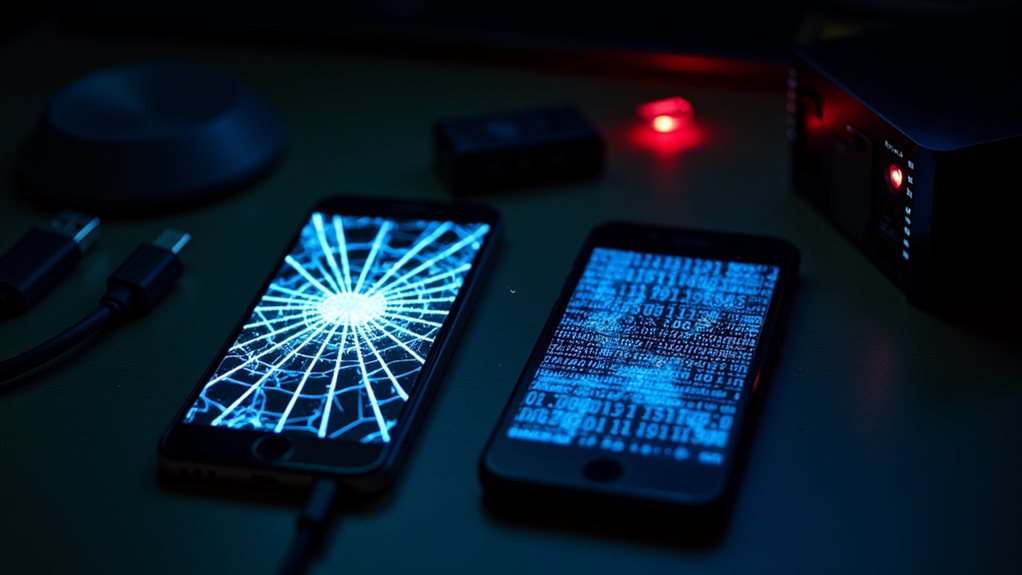Samsung phones currently face the highest volume of hacking attempts worldwide, followed closely by iPhones which receive over 48,000 monthly searches for hacking methods. You'll find these brands are prime targets due to their widespread adoption and larger user demographics, making them attractive to cybercriminals seeking valuable personal data. Both manufacturers' devices store sensitive information and can be vulnerable through various methods, including malware, phishing attacks, and compromised Bluetooth connections. While Samsung logs about 3,100 monthly hack-related searches compared to LG's 670, emerging brands like Xiaomi and Huawei are increasingly targeted in developing nations. Understanding these trends can help you better protect your mobile security.
Most Targeted Phone Brands Today
Phone manufacturers face a constant battle against cybercriminals, with some brands proving more vulnerable than others. When you're looking at brand popularity and user demographics, it's essential to understand which phones attract the most attention from hackers.
Samsung currently leads as the most vulnerable brand, followed closely by iPhone, despite Apple's strong security reputation. Implementing strong security measures can significantly reduce the risk of unauthorized access to your device. In particular, VoIP numbers can be used by scammers to mask their identity and manipulate caller ID, making it crucial to be aware of such tactics.
You'll find it interesting that iPhone users are particularly targeted, with over 48,000 Americans monthly searching for ways to hack these devices. Samsung follows with 3,100 monthly searches, while LG rounds out the top three most-searched brands with 670 monthly queries.
Xiaomi and Huawei, though less targeted in search statistics, remain vulnerable due to their growing market share, especially in developing nations. Many first-time smartphone users choose iPhones, making them attractive targets for scammers.
What makes these brands susceptible isn't just their technical vulnerabilities – it's their widespread adoption. When you're using a popular device, you're part of a larger target demographic that hackers find appealing.
The pre-installed software on these devices can contain exploitable flaws, and your everyday apps like Instagram and WhatsApp become potential entry points for cybercriminals. Understanding the risks associated with VoIP numbers is also essential, as they pose significant threats in scams targeting phone users.
Why Phones Get Hacked
Understanding why hackers target mobile devices reveals a complex web of motivations beyond mere mischief. Your phone's become a digital vault, storing everything from your passwords to your personal photos, making it an irresistible target for cybercriminals who use social engineering and phishing attacks to gain access to your digital life.
You're particularly vulnerable because your mobile device contains a treasure trove of sensitive data in one convenient location. When you store two-factor authentication codes, emails, and login credentials on your phone, you're fundamentally creating a master key that hackers would love to obtain. Bluetooth connections can be exploited by hackers within 30 feet of your device. Recent reports from CERT-In warn that millions of Android users are at serious risk.
They'll often exploit vulnerabilities in your device's components, like the recently discovered issues in Qualcomm chipsets, to gain unauthorized access.
What makes this even more concerning is how easily malware can infiltrate your device through seemingly innocent activities. When you're downloading games or visiting unfamiliar websites, you're potentially exposing yourself to risks.
Once hackers gain control, they can access your corporate networks, turn on your device's camera or microphone, and steal both personal and professional information, potentially contributing to data breaches that cost businesses millions annually.
Common Phone Hacking Methods

Your phone's operating system serves as the first gateway hackers often target, with both Android and iOS having their unique vulnerabilities that can be exploited through various attack methods.
Once they've identified these weak points, cybercriminals frequently attempt password breaches through sophisticated techniques like brute-force attacks or social engineering tactics that trick you into revealing your credentials. Man-in-the-middle attacks are commonly used to intercept sensitive data during transmission between devices. In many cases, compromised unencrypted VoIP calls can also provide hackers with access to sensitive data that can be exploited for malicious purposes.
Security flaws in seemingly harmless apps can provide hackers with backdoor access to your device, allowing them to steal personal data or install malicious software without your knowledge. Unsecured Wi-Fi networks can also create opportunities for data interception when users connect their devices to public hotspots.
Targeting Through Operating Systems
Modern operating systems, despite their sophisticated security measures, remain vulnerable to various hacking methods that can compromise your device's integrity.
You'll find that operating system vulnerabilities often arise from unpatched software bugs that hackers can exploit to gain unauthorized access to your phone. Even more concerning, some attacks don't require any user interaction exploits, allowing cybercriminals to infiltrate your device through zero-click attacks.
When you're using your phone, you mightn't realize that outdated software applications create easy entry points for attackers. Regular monitoring of your device's behavior for signs like unusual battery drain or sluggish performance can help detect potential breaches early. They're constantly searching for these weaknesses, and once they gain root access, they can perform unauthorized actions that put your data at risk. In fact, over 1 million new malware samples targeting mobile devices are detected every day.
What's particularly troubling is that malicious apps can slip through even legitimate app stores, masquerading as harmless software while containing dangerous malware.
To protect yourself, you'll want to stay vigilant about keeping your operating system and apps updated. Think of these updates as your phone's immune system – they patch vulnerabilities and strengthen your device's defenses against the latest hacking techniques that target operating systems.
Password Breach Tactics
Beyond operating system vulnerabilities, password breaches represent one of the most common ways hackers gain unauthorized access to phones.
You're likely familiar with basic password management, but hackers have developed sophisticated methods to bypass even careful users' credential safety measures. Through tactics like brute-force attacks and phishing schemes, cybercriminals can crack weak passwords or trick you into revealing your login information. User carelessness with permission prompts often creates additional security vulnerabilities. Experts recommend using passwords over 12 characters to significantly strengthen account security. Additionally, many of the same techniques used to exploit VoIP vulnerabilities can also apply to phone systems, exposing sensitive information through security risks.
What's particularly concerning is how hackers combine multiple strategies to access your device. They'll often start with social engineering, pretending to be trusted contacts or legitimate services, while simultaneously employing technical methods like keylogging or man-in-the-middle attacks.
If you're using the same password across multiple accounts, you're especially vulnerable – once hackers breach one account, they'll try those credentials everywhere.
Even more alarming is the rise of SIM swapping, where criminals impersonate you to your mobile carrier to gain control of your phone number. This tactic can bypass two-factor authentication, making it essential to maintain unique, strong passwords and be vigilant about suspicious communications requesting your credentials.
App-Based Security Vulnerabilities
While many users focus on password security, app-based vulnerabilities have become a prime target for phone hackers. You'll find that seemingly harmless apps can harbor serious security risks, from insecure coding practices to embedded malware that compromises your device's integrity.
When you download apps from unofficial sources or side-load them onto your device, you're bypassing essential security checks that app stores typically provide. Hackers exploit these app vulnerabilities through various methods, including reverse engineering vulnerable binaries and targeting insecure data storage systems.
If you're using a rooted Android or jailbroken iOS device, you're particularly susceptible to these attacks. Additionally, weak encryption methods in VoIP communications can be a significant vulnerability, making it paramount to remain proactive about your device's security.
To protect yourself, you'll want to stick to trustworthy app sources and keep your apps updated regularly. Pay attention to the permissions each app requests, and don't hesitate to deny unnecessary access to your device's features.
Remember that secure coding practices by developers play a vital role, but you're ultimately responsible for monitoring suspicious activities on your phone. By staying vigilant and following these preventive measures, you'll greatly reduce your risk of falling victim to app-based attacks.
Warning Signs of Phone Hacking
Recognizing signs of phone hacking up front can help you detect and stop cybercriminals before they cause serious damage. When your phone exhibits unusual battery drain or experiences suspicious activity, you'll want to investigate immediately, as these are often the first indicators that something's wrong.
You're not alone if you've noticed your device behaving strangely. Watch for unexplained spikes in data usage, unrecognized apps appearing on your screen, or your phone's performance suddenly declining. If you're receiving strange text messages or seeing unfamiliar calls in your history, these could signal that hackers have compromised your device.
Pay attention to systemic issues like persistent overheating, frequent screen freezes, or unauthorized connections. You can check for potential security breaches by dialing specific codes: *#06# reveals your IMEI number, while *#21# helps detect if someone's tracking your device. Implementing advanced encryption protocols can significantly enhance your phone's security against such threats.
If you discover multiple warning signs, don't hesitate to investigate further or consult a cybersecurity expert. Remember, early detection is essential in preventing data theft and protecting your digital privacy.
Essential Phone Security Tips

State-of-the-art security measures can protect your phone from increasingly sophisticated cyber threats. The foundation of your defense starts with robust password management and biometric security features like fingerprint scanning or facial recognition.
You'll want to enable two-factor authentication for your important accounts and set up a carrier PIN to prevent SIM-swapping attacks.
Keep your device's software current by enabling automatic updates, which patch vulnerabilities that hackers might exploit. If you're using public Wi-Fi, always connect through a VPN to encrypt your data.
Remember to turn off Wi-Fi and Bluetooth when you're not using them to prevent unauthorized connections.
Your physical device security is just as essential as digital protection. Keep your phone with you or in secure locations, and enable remote wiping capabilities in case of theft.
Don't trust public USB charging stations, as they can be compromised. Instead, use your own charger and power bank.
Make it a habit to restart your device weekly to clear potential malware, and stick to encrypted communication apps for sensitive information. Additionally, remember that neglecting VoIP security measures can expose sensitive communications to risks, reinforcing the importance of strong security practices.
These practices will considerably reduce your risk of becoming a target.
Latest Mobile Security Trends
The mobile security landscape in 2024 reveals alarming trends in cyber threats. You'll find that mobile malware has reached unprecedented levels, with security firms detecting hundreds of thousands of malicious files daily, most targeting your smartphones.
As part of your digital community, you're likely aware that popular brands like Samsung and iPhone are prime targets due to their widespread use.
What's particularly concerning is how phishing techniques have evolved to exploit your always-connected lifestyle. You're now facing sophisticated SMiShing attacks through text messages, while traditional email phishing continues to adapt.
If you're using your personal device for work through BYOD programs, you're exposed to additional risks that cybercriminals are keen to exploit.
The impact of these threats isn't just theoretical – major companies you trust have faced devastating breaches, resulting in billions of compromised records and massive financial losses.
While you might think your device is secure, pre-installed software vulnerabilities and delayed updates could leave you exposed.
To stay protected in this evolving landscape, you'll need to prioritize mobile security and stay informed about emerging threats targeting your devices.
Frequently Asked Questions
Can Hackers Still Access My Phone if It's Completely Turned Off?
When your phone's completely off, you're generally safe from active hacking, but don't let your guard down. Advanced hacking methods can still install malware that activates once you power up your device again.
How Long Does It Typically Take for Hackers to Break Into Phones?
Different hacking techniques can breach your phone within hours. If hackers find vulnerabilities, they'll typically need 3-5 hours to gain access, though skilled attackers might compromise your device in under an hour.
Does Airplane Mode Protect My Phone From Being Hacked?
While airplane mode enhances your phone's security by blocking external connections, it won't protect you from existing malware. You'll still need strong passwords, regular updates, and encryption for complete protection against hacking risks.
Are Factory-Reset Phones Completely Free From Previous Hacking Attempts?
No, your factory-reset phone isn't completely safe from previous hacking attempts. Some sophisticated hacking methods can persist in firmware, and advanced data recovery techniques could potentially access remnants of previously compromised information even after resetting.
Can Hackers Access My Phone Through Bluetooth Even When It's Not Visible?
Yes, you're still vulnerable even when your phone's not visible. Hackers can use advanced Bluetooth security exploits and hacking techniques like brute force attacks to find your device's MAC address and gain unauthorized access.
Final Thoughts
Your phone's security isn't something you can afford to take lightly in today's digital landscape. While all devices face risks, you'll greatly reduce your chances of being hacked by implementing strong passwords, enabling two-factor authentication, and keeping your software updated. Remember, it's not just about which phone you're using—it's about how well you're protecting it through smart security practices and constant vigilance.

